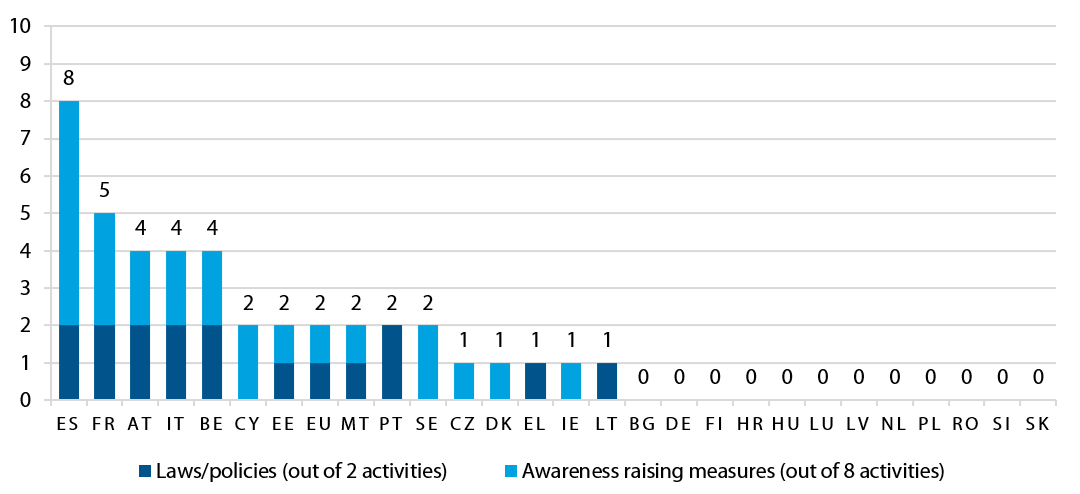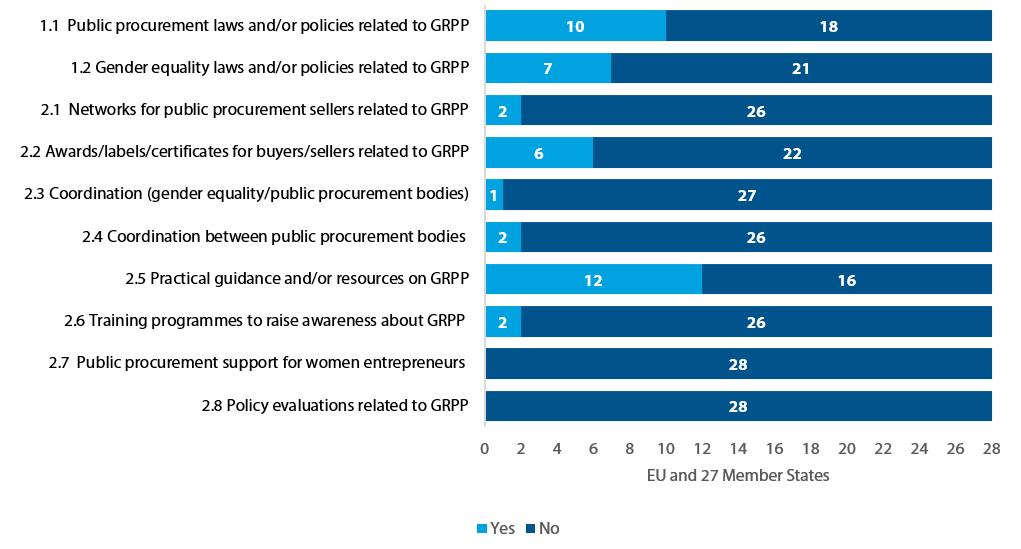Gender-responsive Public Procurement (GRPP) is procurement that promotes gender equality through the goods, services or works being purchased. GRPP can be a driver towards promoting equal employment opportunities and social inclusion for women and men, providing equal opportunities for women and men at all stages of the supply chain and addressing gender pay gap inequalities in the labour market.
EIGE has conducted extensive research on GRPP in the EU, resulting in the publication of an online step-by-step toolkit, a factsheet and a report on GRPP in the EU which presents key findings, selected case studies and policy recommendations.
In 2022, EIGE collected data on the existence of the following two GRPP activities at the EU and Member State levels:
- Legislative and/or policy frameworks related to GRPP.
- Awareness of GRPP amongst buyers and sellers of public procurement.[1]
EIGE has developed 10 GRPP indicators, measuring the existence of the following activities at the EU and Member State levels:
|
Types of GRPP measures |
EIGE’s indicators on GRPP |
|
|---|---|---|
|
1. Existence of legislative and/or policy frameworks related to GRPP |
Indicator 1.1 |
Existence of legislative and/or policy frameworks in the area of public procurement related to GRPP. |
|
Indicator 1.2 |
Existence of legislative and/or policy frameworks in the area of gender equality related to GRPP. |
|
|
2. Awareness of GRPP amongst buyers and sellers of public procurement |
Indicator 2.1 |
Existence of networks for public procurement sellers related to GRPP. |
|
Indicator 2.2 |
Existence of awards, labels, and/or certificates related to GRPP. |
|
|
Indicator 2.3 |
Existence of regular and/or formal coordination between gender equality and public procurement bodies to promote GRPP. |
|
|
Indicator 2.4 |
Existence of regular and/or formal coordination between public procurement bodies to promote GRPP. |
|
|
Indicator 2.5 |
Existence of practical guidance and/or resources on GRPP. |
|
|
Indicator 2.6 |
Existence of training programmes to raise awareness on GRPP amongst staff of public procurement bodies. |
|
|
Indicator 2.7 |
Existence of initiatives to facilitate the participation of women entrepreneurs in the public procurement process. |
|
|
Indicator 2.8 |
Existence of policy evaluations related to GRPP. |
|
Table 1: Indicators measuring the existence of GRPP activities.
Source: EIGE’s 2022 data collection on Gender-responsive Public Procurement.
GRPP measures are not widely adopted in the EU
Findings from EIGE’s 2022 data collection exercise on GRPP in the EU indicate that GRPP activities have not been widely adopted at the EU level nor at the individual Member State level. Few Member States have implemented laws/policies at the national level related to GRPP or have established measures to promote awareness on GRPP amongst buyers and sellers of public procurement.
Figure 1 presents the GRPP ‘scores’ of Member States and of the EU. Each point represents a type of GRPP activity that has been identified at the EU or national level, based on EIGE’s 10 indicators. For instance, a score of 8 indicates that 8 out of the 10 activities outlined in EIGE’s indicators were identified at the EU level, or in a given Member State.
Figure 1: GRPP scores assigned to the EU and Member States (out of 10).

Source: EIGE’s 2022 data collection on Gender-responsive Public Procurement.
As illustrated in Figure 1:
- Spain has the highest GRPP ‘score’, as 8 out of 10 GRPP activities have been identified at the national level.
- The remaining 14 Member States in which GRPP activities have been identified, scored between 1 and 5 (BE, CZ, DK, EE, IE, EL, FR, IT, CY, LT, MT, PT, AT and SE).
- At the EU level, 2 out of 10 GRPP activities have been identified.
- GRPP activities were not identified in 12 countries, resulting in a score of 0 (BG, DE, HR, LV, LU, HU, NL, PL, RO, SI, SK, and FI).
The publication of practical guidance is the most widely adopted GRPP activity in the EU
The publication of practical guidance on GRPP (Indicator 2.5) is the most widely adopted activity in the EU. This activity has been identified at the EU level, and at the national level in eleven Member States (BE, CZ, DK, EE, IE, ES, FR, IT, CY, AT, and SE).
The existence of legislative and/or policy frameworks related to GRPP in the area of public procurement (Indicator 1.1) are also more widespread, compared to the other GRPP measures. These laws/policies were identified in ten Member States (BE, EE, EL, ES, FR, IT, LT, MT, AT, and PT).
Figure 2: Number of jurisdictions (EU and 27 Member States) that have adopted GRPP activities (per indicator).

Source: EIGE’s 2022 data collection on Gender-responsive Public Procurement.
Notes about the data
More detailed findings on the existence of GRPP activities in the EU can be found in EIGE’s Gender Statistics Database.
Data collection was conducted by national researchers in each EU Member State through online desk research and interviews with public procurement authorities. Further details on EIGE’s methodological approach for collecting data on GRPP in the EU can be found in the accompanying methodological report.
[1] Buyers of public procurement are contracting authorities purchasing goods and services through public contracts. Sellers are suppliers/contractors that provide goods and services through public contracts.